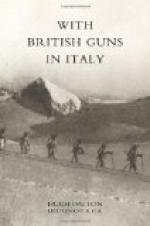But the Italians held grimly on; they turned at bay on the Piave and in the mountains, and checked the onrush of Austrians and Germans. Then, supported by French and British reinforcements, but still inferior in numbers, they continued for a year longer to hold up almost the whole strength of Austria. That winter the poor were very near starvation in the cities of Italy, and the peasants had to cut down their olive groves for fuel. The following spring part of the French and British reinforcements were withdrawn to France, together with an Italian contingent which numerically balanced the French and British who remained in Italy.
The Austrians also lost their German support and sent some of their own troops to France, but they retained their numerical superiority on the Italian Front. In June they launched a great attack on a seventy-mile front, which was to have made an end of Italy; but the Italians beat them back. Then four months later, after an intense effort of preparation, Italy, still inferior in numbers and material, struck for the last time and utterly destroyed the Austrian Army in the great battle which will be known to history as Vittorio Veneto. The Austrians lost twice as many prisoners and four times as many guns at Vittorio Veneto as they had taken at Caporetto.
The war on the Italian Front was over, the Austrian Army was broken beyond recovery, the Austrian State was dissolving into its national elements, which only tradition, corruption and brute force had for so long held together. Italy, heroic and constant, had endured to the end, and with her last great gesture had both completed her own freedom, and given their freedom to those who had been the instruments of her enemies.
PART II
SOME EARLY IMPRESSIONS
CHAPTER II
FROM FOLKESTONE TO VENICE
On the 6th July, 1917, I arrived at Folkestone armed with a War Office letter ordering my “passage to France for reinforcements for Siege Artillery Batteries in Italy.” I had a millpond crossing in the afternoon, and that evening left Boulogne for Modane.




